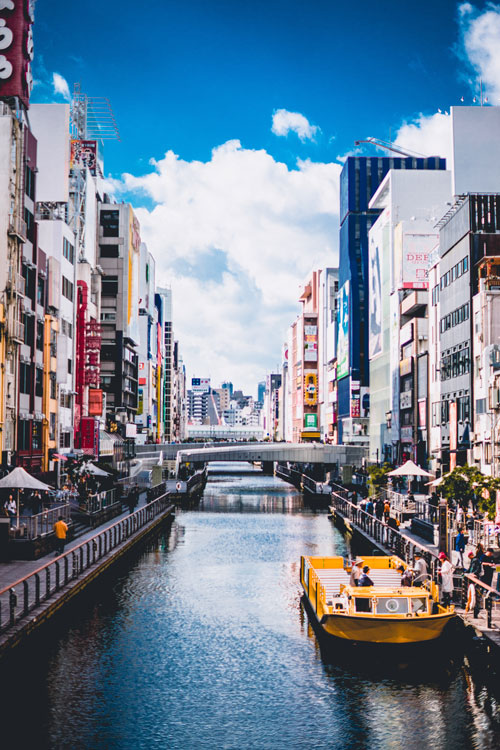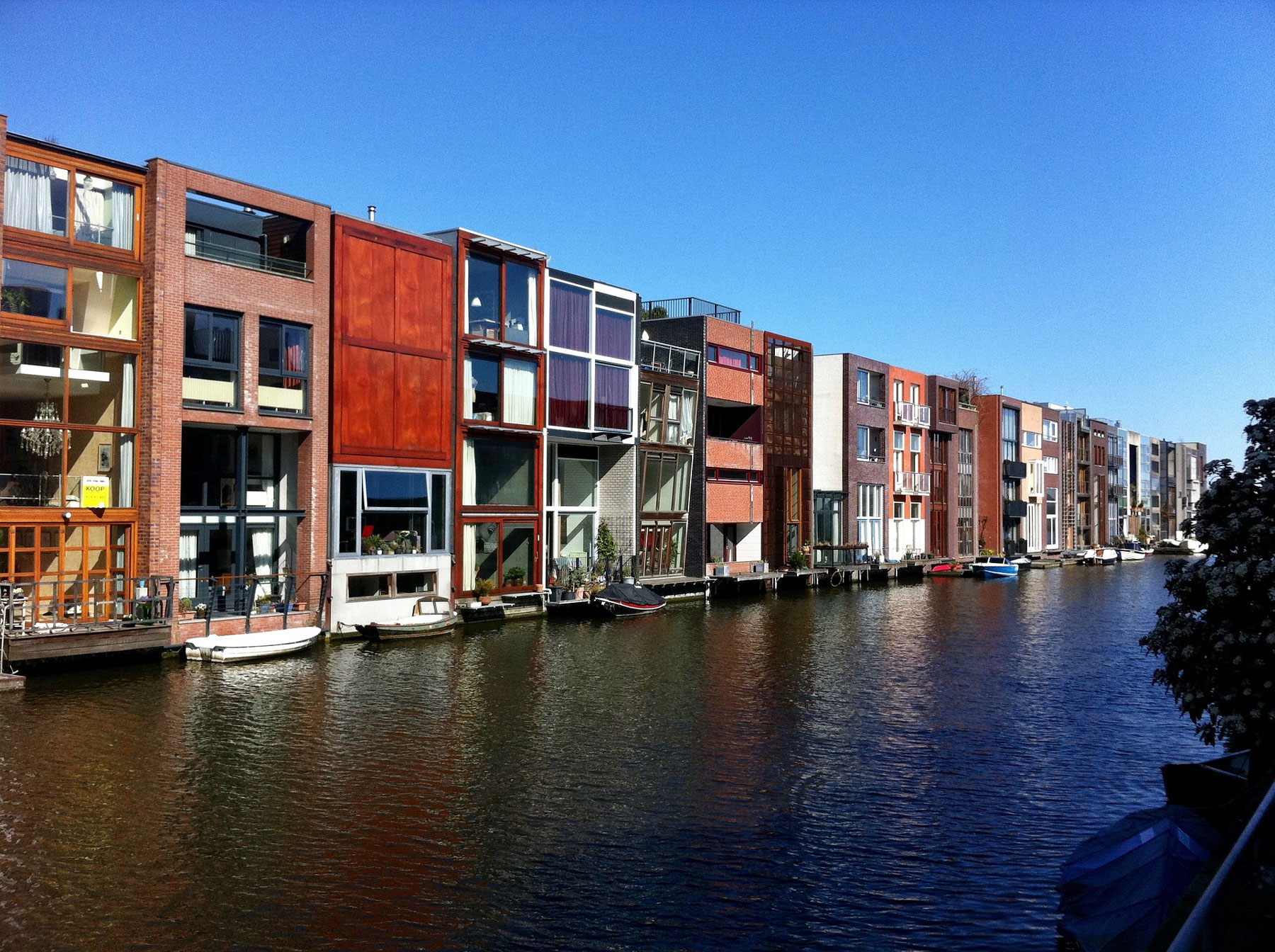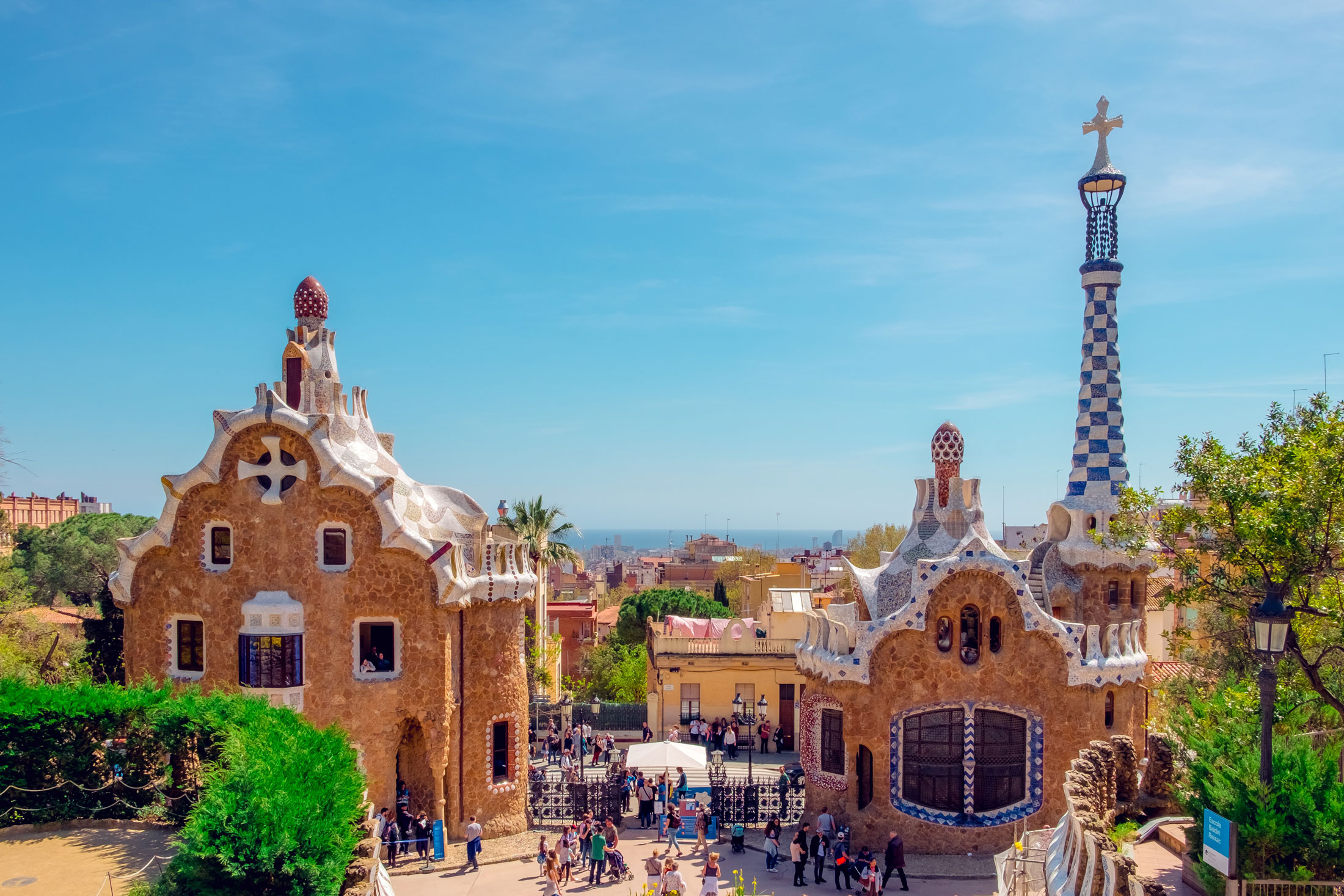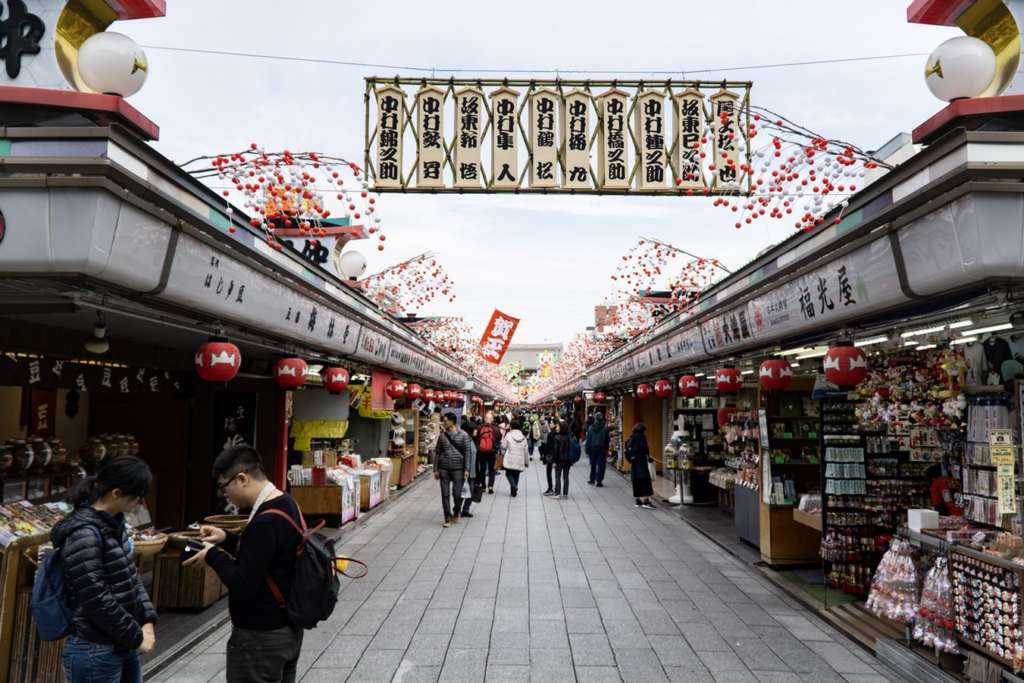
Updated: 11 November 2019
Ancient temples, western influences, and icons of Japanese architecture and design. It’s all found here in Tokyo, the city of culture, cuisine, and shopping centres.
Below is the MUST-SEE Architecture in Tokyo. I hope you find it useful as you wander its busy streets (there’s a map at the bottom to guide you around). As you see with the date at the top, this list is always updating as new projects are completed. If you want to see your photo featured, hashtag #AVONTUURA on Instagram and I will try my best to include it.
Onwards!
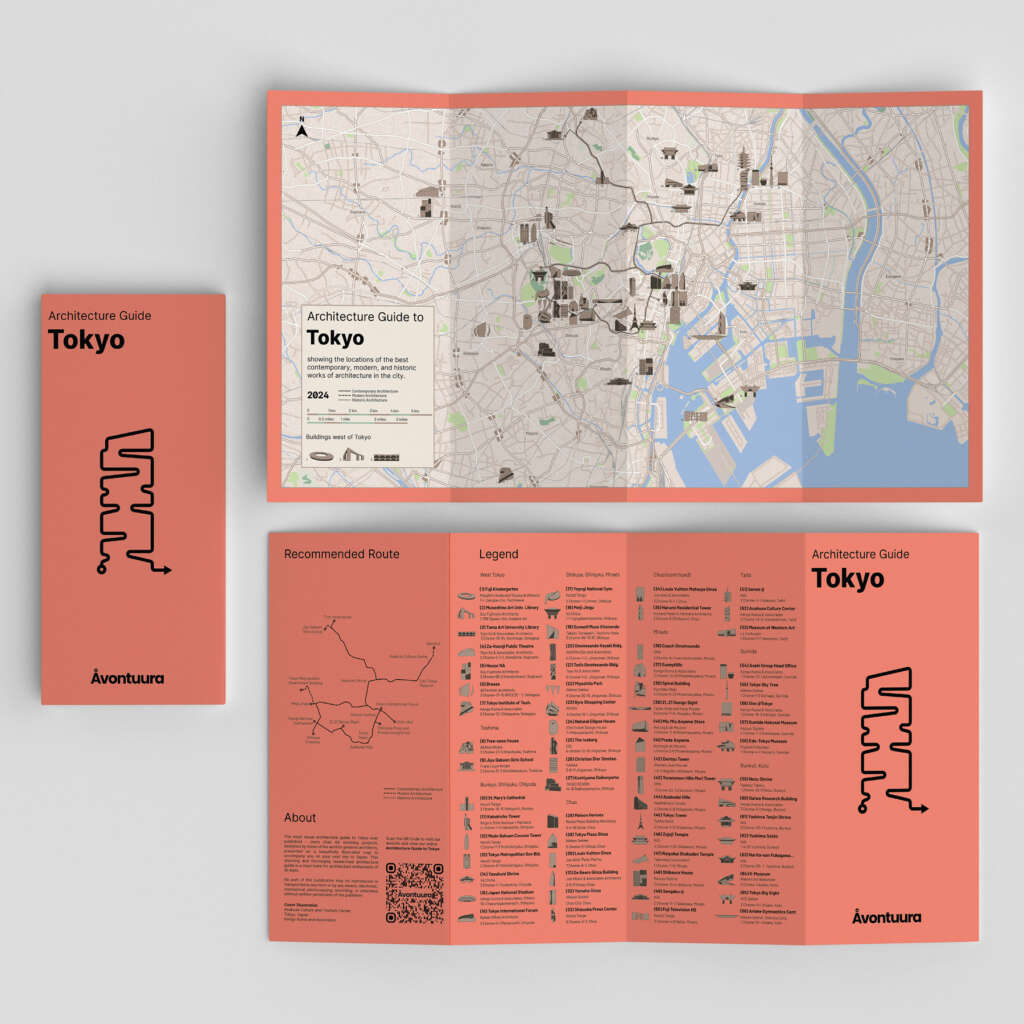
Architecture Guide to Tokyo
Explore all our guides at avontuura.com/shop
Contemporary Architecture
Asakusa Culture and Tourism Center
Located in the Taitō district of Tokyo, Asakusa is famous for the Sensō-ji, a local Buddhist temple in the area. The design of the culture and tourism center is a clever combination of both function and tradition in this regard. The building houses several different functions from the neighborhood’s tourist information center, to exhibition spaces, multi-purpose and conference rooms. Architect Kengo Kuma saw this as an opportunity to create a vertical village that espouses a vernacular quality in a contemporary way.
Visiting Information
Architect: Kengo Kuma
Built: 2012
Type: Visitor’s Center
Address: Japan, 〒111-0034 Tōkyō-to, Taitō-ku, 台東区Kaminarimon, 2 Chome−18−9
Open to the Public: Yes
Hours: Daily: 9:00am – 8:00pm
Website: www.city.taito…
Fuji Kindergarten
View this post on Instagram
Shaped like a giant halo, Japan’s largest kindergarten has no interior walls to emphasize the concept of no-barriers, allowing kids total freedom inside and out. At 2.1m tall, the building is extremely short by contemporary standards and is designed to be closer to the ground to match the height of its primary users. Two zelkova trees pass through the roof deck letting kids climb it as part of their playtime. Along with windows along the perimeter, there are no hiding places which allow for easy supervision for the adults.
Visiting Information
Architect: Masahiro Ikeda and Tezuka Architects
Built: 2007
Type: Kindergarten
Address: 7-1, Sangsa-cho, Tachikawa City
Open to the Public: No
Website: www.fujikids.jp
Tama Art University Library
The Tama Art University Library is a largely-restrained, yet elegant building designed by Pritzker Prize-winning Japanese architect Toyo Ito. Known for his exploration of form and structure (often working in unison with each other), the library is an open space designed as a gallery for teachers and students to meet and share ideas. The design is most noted for its slender, concrete arches that provide a delicate canopy over the interior spaces while allowing natural light to flood in.
Visiting Information
Architect: Toyo Ito
Built: 2007
Type: Library
Address: Japan, 〒158-0093 Tokyo, Setagaya, Kaminoge, 3 Chome−15−34
Open to the Public: Yes
Website: www.tamabi.jp…
21_21 Design Sight
Visting Information
Architect: Tadao Ando and Issey Miyake
Built: 2007
Type: Desapan, 〒107-6290 Tōkyō-to, Minato-ku, 港区Akasaka, 9 Chome−9−7−6 東京ミッドタウン・ガーデン内
Open to the Public: Yes
Hours: Wednesday – Monday: 10:00am – 7:00pm (except Tuesday)
Website: www.2121designsight.jp
Musashino Art University Library
The Musashino Art University Library is a library made entirely out of bookshelves. The building has a spiral shape representing a “clock of numbers” with each turn representing a different category, making way-finding very intuitive. The outside of the building is also clad in bookshelves should the library ever expand.
Visiting Information
Architect: Sou Fujimoto
Built: 2011
Address: 1-736 Ogawa-cho, Kodaira-shi, Tokyo, Japan
Open to the Public: Yes
Hours: Wednesday – Monday: Daily, 10:00am – 6:00p (except Tuesday)
Website: www.mauml.ac.jp…
Za-Koenji Public Theatre
While its odd shape and color may seem quite arbitrary, the design for Za-Koenji Public Theatre was the result of significant consideration of its surrounding context. Located in Tokyo’s Suginami Ward, the theatre sits in the middle of several residential buildings that brought along with it several sound and height restrictions. Its all-black exterior and lack of openings ensure that noise and sound generated in the theatre are kept within the walls. Its irregular shape is actually 5 elliptic cones and 2 cylinders carved out of a cube that responds to the different roof heights of the adjoining buildings.
Visiting Information
Architect: Toyo Ito
Built: 2009
Type: Public Theatre
Address: Japan, 〒166-0002 Tōkyō-to, Suginami-ku, Kōenjikita, 2 Chome−2−1−2
Open to the Public: Yes
Hours: Open daily: 11:00am – 8:00pm (except Tuesday)
Website: www.za-koenji.jp…
Natural Ellipse House
View this post on Instagram
Located in one of Tokyo’s busiest shopping areas, the Natural Ellipse House is completely responsive to its environment with limited opportunity for natural light that is protected from pedestrian onlook. As a result, the introverted design looks inward with a unique structure composed of laser-cut iron ribs. Its ivory-white skin is made of fiber-reinforced polymer sheets that were created on site meaning that there are no seams present.
Visiting Information
Architect: EDH Endoh Design House, Masahiro Ikeda
Built: 2002
Type: Private Residence
Address: 7-1 Maruyamachō, Shibuya-ku, Tokyo, Japan
Open to the Public: No
Prada Flagship Store
The work of noted Swiss architectural firm Herzog & de Meuron, Prada Flagship store Tokyo is a remarkably beautiful building, shaped like a giant crystal that appears to change its shape as you walk around it. Its glass is quite unique and varies from flat to convex and concave surfaces that are held together by rhomboid-shaped metal frames. Its this rich combination of glass that creates a visual interplay between inside and out, giving those around it a sense of wonder as they paruse the products around them.
Visiting Information
Architect: Herzog & de Meuron
Built: 2017
Type: Retail
Address: Japan, 〒107-0062 Tokyo, Minato, Minamiaoyama, 5−2−6
Open to the Public: Yes
Hours: Daily: 11:00am – 8:00pm (9:00pm Friday to Sunday)
Gyre Shopping Center
A 7-storey retail building in Tokyo’s Omotesando shopping district, the design was based on providing floor-to-floor flexibility for retailers while providing a unique vertical shopping experience. Dutch firm MVRDV accomplished this by stacking and twisting the individual program to create a series of stepped terraces around the building. The terraces are connected by two sets of stairs for shoppers. One for ascending, and one for descending.
Visiting Information
Architect: MVRDV
Built: 2007
Type: Shopping Center
Address: Japan, 〒150-0001 Tokyo, Shibuya, Jingumae, 5−10−1
Open to the Public: Yes
Hours: Daily: 11:00am – 12:00am
Website: www.gyre-omotesando.com
Christian Dior Omotesando
View this post on Instagram
Designed by Japanese firm SANAA, the Dior Omotesando is best visited at night. That’s because its otherwise rational shape and layout transform into a light show of color and elegance thanks to a translucent acrylic glass that illuminates after sunset.
Visiting Information
Architect: SANAA
Built: 2003
Type: Retail
Address: 5-9-11 Jingumae, Shibuya-ku, Tokyo 150-0001
Open to the Public: Yes
Hours: Daily, 10:00am – 8:00Pm
Tod’s Omotesando Building
View this post on Instagram
Located on Tokyo’s infamous Omotesando Avenue, the Toyo Ito-designed building is a concrete, tree-like structure that wraps around the building to free-up the interior space for shopping.
Visiting Information
Architect: Toyo Ito & Associates
Built: 2004
Type: Retail
Address: 5-1-15 Jingumae, Shibuya-ku, Tokyo, Japan
Open to the Public: Yes
Maison Hermès
View this post on Instagram
Italian architect Renzo Piano designed the flagship store and corporate offices for Hermès in Tokyo’s Ginza district. The building is very slender at only 12 meters wide and is characterized for its use of custom glass blocks designed and manufactured in Florence. To withstand Tokyo’s significant seismic regulations, the glass blocks were fitted with a steel grid allowing for shifts up to 4mm during earthquakes.
Visiting Information
Architect: Renzo Piano Building Workshop (RPBW)
Built: 2001
Type: Retail
Address: 5-4-19 Ginza, Chuo-ku, Tokyo, Japan
Open to the Public: Yes
Mode Gakuen Cocoon Tower
Completed in 2008, the Mode Gakuen Cocoon Tower is the second tallest education tower in the world. The building is home to three separate institutions specializing in fashion, technology, and medicine. The architect Kenzo Tange, won a competition for its design based on the concept of a “cocoon” due to its nurturing qualities. This is emphasized by the nest-like use of the aluminum screen that wraps the building.
Visiting Information
Architect: Kenzo Tange
Built: 2008
Type: Vertical Campus
Address: Japan, 〒160-0023 Tōkyō-to, Shinjuku-ku, 新宿区Nishishinjuku, 1 Chome−7−3
Open to the Public: Yes
De Beers Ginza Building
View this post on Instagram
The client, De Beers Jewellers, wanted a building that had a feminine form and sparkled like its product. As a response, local firm Jun Mitsui & Associates Architects took inspiration for the building from a waving ribbon of light rising out of the earth as an aurora. These qualities are enhanced through custom stainless steel pipes that create sparkles of light throughout the vertical surface of the tower.
Visiting Information
Architect: Jun Mitsui & Associates Architects
Built: 2008
Type: Office
Address: 2-5-11 Ginza, Chuo-ku, Tokyo, Japan
Open to the Public: Yes
Dentsu Tower
View this post on Instagram
Designed for Japanese media company Dentsu, for architect Jean Nouvel, the design of the tower was about simplicity and respect for both its occupants, and for the City as a while. The tower’s slender and elegant silhouette along Tokyo’s primary skyline speaks to the countries modesty while horizontal shading on its other faces provides comfort and shading for its occupants inside.
Visiting Information
Architect: Atelier Jean Nouvel
Built: 2003
Type: Office
Address: 1-5-3 Higashi-shimbashi, Minato-Ku, Shiodome area, Tokyo, Japan
Open to the Public: Yes
Dentsu Caretta at Shiodome
View this post on Instagram
Located at the base of Jean Nouvel’s office tower for Japanese media company Dentsu, the design is a public refuge for workers complete with restaurants, cafes, a library, museum, theatre, and shopping center. The metaphor of a rock is used throughout the design to symbolize its position at the base of the tower and gives the space a “carved-out” feel complete with a waterfall and natural light.
Visiting Information
Architect: JERDE
Built: 1998
Type: Office, Retail
Address: 1-8-2 Higashi-Shimbashi, Minato-ku, Tokyo, Japan
Open to the Public: Yes
K-Museum
View this post on Instagram
Imagine a city, reclaimed from the sea with an elaborate infrastructure but no buildings. K-Museum documents the lost waterfront city called Odaiba. Located at the very head of Tokyo Bay, the museum was designed to showcase the hidden infrastructure that keeps Tokyo functioning. After a terrible recession hit Japan in the 1980’s, the proposed development in the area went bankrupt and museum closed with it. Development has since picked up in the area in recent years and the possibility of reopening the K-Museum exists.
Visiting Information
Architect: Makoto Sei Watanabe
Built: 1996
Type: Museum (closed)
Address: koto-k, ariake 3-1, Tokyo, Japan
Open to the Public: No
Kabukicho Tower
This compact tower designed by Rogers Stirk Harbour + Partners is the response to a very challenging site where the streets are very narrow and constrained. Access to daylight was the biggest challenge facing the architects, and their solution was a lightweight glass façade that cantilevers over the underground shopping and restaurant area.
Visiting Information
Architect: Rogers Stirk Harbour + Partners
Built: 1993
Type: Office
Address: Kabuki-cho, Shinjuku-cho, Tokyo, Japan
Open to the Public: Yes
Tokyo Big Sight
View this post on Instagram
Completed in 1996, the Tokyo International Exhibition Center or “Big Sight” as it’s nicknamed is the largest convention venue in Japan. The building is easily characterized by the four inversed pyramids that form the convention center.
Visiting Information
Architect: AXS Satow
Built: 1996
Type: Exhibition Center
Address: 3-11-1 Ariake, Koto, Tokyo, Japan
Open to the Public: Yes
Tokyo Sky Tree
View this post on Instagram
Over 634 meters tall, the Sky Tree is the tallest broadcasting tower in the world with a restaurant and observation tower.
Visiting Information
Architect: Nikken Sekkei
Built: 2012
Type: Shopping Center
Address: 1 Chome-1-2 Oshiage, Sumida, Tokyo, Japan
Open to the Public: Yes
Hours: Daily, 8:00am – 10:00pm
Cost: Average cost is ¥2,060 ($18.42 US)
Website: www.tokyo-skytree.jp
Modern Architecture
Nakagin Capsule Tower
Easily one of Tokyo’s most recognizable buildings, the Nakagin Capsule Tower is a rare example of Japanese Metabolism that is still remaining. The Metabolists emerged out of postwar Japan and their designs were inspired by organic biological growth. The building consists of two concrete towers, eleven and thirteen stories each, that hold 140 prefabricated concrete capsules. The building is at high-risk of being demolished due to the incredibly high cost of renovating each capsule and the squalid living conditions inside.
Visiting Information
Architect: Kisho Kurokawa
Built: 1972
Style: Metabolism
Type: Residential Office Tower
Address: Japan, 〒104-0061 Tōkyō-to, Chūō-ku, Ginza, 8 Chome−8−16−10
Open to the Public: Yes
Website: www.nakagincapsuletower.com
St.Mary’s Cathedral
St. Mary’s Cathedral is a modern cathedral and widely considered architect Kenzo Tange’s greatest work. It is also the seat of the Roman Catholic Archdiocese of Tokyo. The design is credited for its elegant use of concrete by curving the rhomboid-shaped walls as they move vertically to reveal a cross in its roof. The church is inspired by the lightness of a bird and its wings.
Visiting Information
Architect: Kenzo Tange
Built: 1964
Type: Church
Address: Japan, 〒112-0014 Tōkyō-to, Bunkyō-ku, 文京区Sekiguchi, 3 Chome−3−16−15
Open to the Public: Yes
Website: www.tokyo.catholic.jp…
National Museum of Western Art
Designed by renowned architect Le Corbusier, the National Museum of Western Art is his only known building designed in the far east and a UNESCO protected building. The design encompasses several of “Corb”‘s core principles which includes a square or rational building form raised on pilotis. Circulation through the buildings is via a series of ramps with skylights that guide visitors through the building. The facade is detailed with concrete panels.
Visiting Information
Architect: Le Corbusier
Built: 1979
Type: Museum
Address: Japan, 〒102-8322 Tōkyō-to, Chiyoda-ku, Kitanomarukōen, 3−1
Open to the Public: Yes
Hours: Tuesday to Sunday: 9:30am – 5:300pm
Website: www.nmwa.go.jp
Makuhari Messe
Designed by Funihiko Maki, Messe is a German word meaning “trade fair”. The building is a massive convention center outside the city centre that is easily accessible by train or car. The building is most noted for its roof structure comprised of 216m wide and 96m long steel trusses that are held up by slender columns.
Visiting Information
Architect: Fumihiko Maki
Built: 1989
Type: Convention Center
Address: Japan, 〒261-0023 Chiba-ken, Chiba-shi, Mihama-ku, Nakase, 2−1
Open to the Public: Yes
Website: www.m-messe.co.jp
Yoyogi National Gymnasium
Originally designed for the 1964 Summer Olympics, the Yoyogi National Gymnasium is primarily used now for ice hockey and basketball events. The arena is one example of a suspended roof structure which is quite popular in the region. It ultimately became the inspiration for the 1972 Summer Olympic stadium in Munich designed by Frei Otto.
Visiting Information
Architect: Kenzo Tange
Built: 1964
Type: Gymnasium
Address: Japan, 〒150-0041 Tōkyō-to, Shibuya-ku, Jinnan, 2 Chome−1−1
Open to the Public: Yes
Website: jpnsport.go.jp
Asahi Beer Hall
Widely considered one of Tokyo’s most iconic modern structures, the Asahi Beer Hall was designed by French architect Phillipe Starck. The beer hall is shaped like a beer glass to complement the adjacent golden beer glass-shaped offices next door. The large golden structure at the top of the hall is the Asahi Flame and is intended to represent a frosty head. It is completely void of program and was built by a shipbuilding company using submarine construction techniques. It is occasionally and colloquially referred to as “the golden turd”.
Visiting Information
Architect: Phillipe Starck
Built: 1989
Type: Brewery Headquarters
Address: Japan, 〒130-0001 Tokyo, Sumida, Azumabashi, 1 Chome−23−1 スーパードライホール
Open to the Public: Yes
Tokyo International Forum
The Tokyo International Forum is the only major complex that hosts both business and cultural events in the city. The design of the building was awarded through a competition won by Rafael Viñoly in 1989. The forum includes two giant theatres, an exhibition hall, and conference rooms connected by a crystal glass hall with a 60m high curtain wall. The glass is supported by two large columns and is a distinctive shape on the City’s skyline.
Visiting Information
Architect: Rafael Viñoly
Built: 1997
Type: Forum
Address: 3 Chome-5-1 Marunouchi, Chiyoda-ku, Tōkyō-to 100-0005, Japan
Open to the Public: Yes
Tokyo Tower
View this post on Instagram
Located in the Shiba-koen district of Minato, the Tokyo Tower is the second tallest structure and is painted orange and white color to comply with air safety regulations. It was inspired by the Eiffel Tower but despite being taller, is almost half of its measureable weight.
Visiting Information
Architect: Tachū Naitō
Built: 1958
Type: Communications and Observation Tower
Address: 4 Chome-2-8 Shibakoen, Minato, Tokyo, Japan
Open to the Public: Yes
Hours: Daily, 8:00am – 10:00pm
Cost: Average cost is ¥2,060 ($18.42 US)
Website: www.tokyotower.co.jp
Jiyu Gakuen Girls School
Jiyu Gakuen Girls School Myonichikan is one of two buildings designed by Frank Lloyd Wright in Japan. Consisting of four buildings including classrooms and an auditorium, the buildings own the typical Wright trademarks of low roofs, expansive facades, and deep-set openings. To give the buildings a touch of Japan, Oya stone from the Tochigi Prefecture was used for the columns, lanterns, and paving.
Visiting Information
Architect: Frank Lloyd Wright
Built: 1921
Type: Educational
Address: 2 Chome-31-3 Nishiikebukuro, Toshima, Tokyo 171-0021, Japan
Open to the Public: Yes
Hours: Daily, 10:00am – 4:00pm (closed Mondays)
Website: www.jiyu.jp
Traditional Architecture
Meiji Shrine
View this post on Instagram
Visiting Information
Architect: Itō Chūta
Built: 1920
Type: Shrine
Address: 1-1 Yoyogikamizonocho, Shibuya, Tokyo 151-8557, Japan
Open to the Public: Yes
Hours: Varies
Website: www.meijijingu.or.jp
Sensoji Temple
Visiting Information
Built: 645 AD
Style: Japanese Buddhist architecture
Address: 2 Chome-3-1 Asakusa, Taitō, Tokyo 111-0032, Japan
Open to the Public: Yes
Hours: Daily,6:00am – 5:00pm
Website: www.senso-ji.ip/
Nezu Shrine
View this post on Instagram
Practical Information
Founder: Yamato Takeru
Built: 1705
Style: Ishi-no-ma-zukuri
Address: 1 Chome-28-9 Nezu, Bunkyō, Tokyo 113-0031, Japan
Open to the Public: Yes
Website: www.nedujinja.or.jp
Shitennō-ji
View this post on Instagram
Visiting Information
Built: 593
Style: Japanese Buddhist
Address: 1-11-18 Shitennoji, Tennoji Ward, Osaka, Osaka Prefecture 543-0051, Japan
Open to the Public: Yes
Hours: Daily, 8:00am – 5:30pm
Cost: ¥300
Website: www.shitennoji.or.jp
Yushima Seido
View this post on Instagram
Visiting Information
Built: 1690
Style: Temple
Address: 1-4-25 Yushima, Bunkyō, Tokyo 113-0034, Japan
Open to the Public: Yes
Hours: Daily, 9:30am – 5:30pm
Cost: Free
Website: www.seido.or.jp
Narita-san Fukagawa Fudo-Do
View this post on Instagram
Visiting Information
Built: 1703
Style: Confucian Temple
Address: Japan, 〒135-0047 Tokyo, Koto, Tomioka, 1 Chome−18−17 13 富岡和倉ビル
Open to the Public: Yes
Website: www.fukagawafudou.gr.jp
Yushima Tenmangu
View this post on Instagram
Visiting Information
Built: 458 AD
Style: Shinto shrine
Address: 3 Chome-30-1 Yushima, Bunkyō, Tokyo 113-0034, Japan
Open to the Public: Yes
Hours: Daily, 6:00am – 8:00pm
Cost: Free
Website: www.yushimatenjin.or.jp…
Yasukuni Shrine
View this post on Instagram
Visiting Information
Built: 1869
Style: Shinto Shrine
Address: 3 Chome-1-1 Kudankita, Chiyoda, Tokyo 102-8246, Japan
Open to the Public: Yes
Website: www.yasukuni.or.jp
Zojoji Temple
View this post on Instagram
Visiting Information
Built: 1393
Type: Jōdo-shū Buddhist temple
Founder: Yūyo Shōsō
Address: 4丁目-7-35 Shibakoen, Minato, Tokyo 105-0011, Japan
Open to the Public: Yes
Website: www.zojoji.or.jp/en
Sengakuji Temple
View this post on Instagram
Visiting Information
Built: 1393
Type: Sōtō Zen Buddhist Temple
Address: 2 Chome-11-1 Takanawa, Minato, Tokyo 108-0074, Japan
Open to the Public: Yes
Hours:
April to September 7:00am – 6:00pm
October to March 7:00am – 5:00pm
Cost: Free
Website: www.sengakuji.or.jp…
We do our best to provide accurate and up-to-date information, locations, and opening hours whenever possible. It is recommended that you double-check any information that you may need to ensure your visit is a success.
Want to see your picture featured or wish to have it removed? Send all inquiries to karl@avontuura.com
Architect: Frank Lloyd Wright
Built: 1921
Type: Educational
Address: 2 Chome-31-3 Nishiikebukuro, Toshima, Tokyo 171-0021, Japan
Open to the Public: Yes
Hours: Daily, 10:00am - 4:00pm (closed Mondays)
Website: https://www.jiyu.jp/
Architect: Tachū Naitō
Built: 1958
Type: Communications and Observation Tower
Address: 4 Chome-2-8 Shibakoen, Minato, Tokyo, Japan
Open to the Public: Yes
Hours: Daily, 8:00am - 10:00pm
Cost: Average cost is ¥2,060 ($18.42 US)
Website: http://www.tokyo-skytree.jp/en/
Architect: Fumihiko Maki
Built: 1989
Type: Convention Center
Address: Japan, 〒261-0023 Chiba-ken, Chiba-shi, Mihama-ku, Nakase, 2−1
Open to the Public: Yes
Website: m-messe.co.jp
Architect: Nikken Sekkei
Built: 2012
Type: Shopping Center
Address: 1 Chome-1-2 Oshiage, Sumida, Tokyo, Japan
Open to the Public: Yes
Hours: Daily, 8:00am - 10:00pm
Cost: Average cost is ¥2,060 ($18.42 US)
Website: http://www.tokyo-skytree.jp/en/
Architect: AXS Satow
Built: 1996
Type: Exhibition Center
Address: 3-11-1 Ariake, Koto, Tokyo, Japan
Open to the Public: Yes
Architect: Rogers Stirk Harbour + Partners
Built: 1993
Type: Office
Address: Kabuki-cho, Shinjuku-cho, Tokyo, Japan
Open to the Public: Yes
Architect: Makoto Sei Watanabe
Built: 1996
Type: Museum (closed)
Address: koto-k, ariake 3-1, Tokyo, Japan
Open to the Public: No
Architect: JERDE
Built: 1998
Type: Office, Retail
Address: 1-8-2 Higashi-Shimbashi, Minato-ku, Tokyo, Japan
Open to the Public: Yes
Architect: Jun Mitsui & Associates Architects
Built: 2008
Type: Office
Address: 2-5-11 Ginza, Chuo-ku, Tokyo, Japan
Open to the Public: Yes
Architect: Renzo Piano Building Workshop (RPBW)
Built: 2001
Type: Retail
Address: 5-4-19 Ginza, Chuo-ku, Tokyo, Japan
Open to the Public: Yes
Architect: Toyo Ito & Associates
Built: 2004
Type: Retail
Address: 5-1-15 Jingumae, Shibuya-ku, Tokyo, Japan
Open to the Public: Yes
Architect: SANAA
Built: 2003
Type: Retail
Address: 5-9-11 Jingumae, Shibuya-ku, Tokyo 150-0001
Open to the Public: Yes
Hours: Daily, 10:00am - 8:00Pm
Architect: Sou Fujimoto
Built: 2011
Address: 1-736 Ogawa-cho, Kodaira-shi, Tokyo, Japan
Open to the Public: Yes
Hours: Wednesday - Monday: Daily, 10:00am - 6:00p (except Tuesday)
Website: https://mauml.musabi.ac.jp/en/
Architect: Masahiro Ikeda and Tezuka Architects
Built: 2007
Type: Kindergarten
Address: 7-1, Sangsa-cho, Tachikawa City
Open to the Public: No
Website: https://fujikids.jp/ (Japanese)
Architect: EDH Endoh Design House, Masahiro Ikeda
Built: 2002
Type: Private Residence
Address: 7-1 Maruyamachō, Shibuya-ku, Tokyo, Japan
Open to the Public: No
Architect: Rafael Viñoly
Built: 1989
Type: Brewery Headquarters
Address: 3 Chome-5-1 Marunouchi, Chiyoda-ku, Tōkyō-to 100-0005, Japan
Open to the Public: Yes
Architect: Phillipe Starck
Built: 1989
Type: Brewery Headquarters
Address: Japan, 〒130-0001 Tokyo, Sumida, Azumabashi, 1 Chome−23−1 スーパードライホール
Open to the Public: Yes
Architect: Kenzo Tange
Built: 1964
Type: Gymnasium
Address: Japan, 〒150-0041 Tōkyō-to, Shibuya-ku, Jinnan, 2 Chome−1−1
Open to the Public: Yes
Website: jpnsport.go.jp
Architect: Toyo Ito
Built: 2007
Type: Library
Address: Japan, 〒158-0093 Tokyo, Setagaya, Kaminoge, 3 Chome−15−34
Open to the Public: Yes
Website: www.tamabi.ac.jp/english/about/library.htm
Architect: Toyo Ito
Built: 2009
Type: Public Theatre
Address: Japan, 〒166-0002 Tōkyō-to, Suginami-ku, Kōenjikita, 2 Chome−2−1−2
Open to the Public: Yes
Hours: Open daily: 11:00am - 8:00pm (except Tuesday)
Website: za-koenji.jp/home/index.php
Architect: Kenzo Tange
Built: 2015
Type: Vertical Campus
Address: Japan, 〒160-0023 Tōkyō-to, Shinjuku-ku, 新宿区Nishishinjuku, 1 Chome−7−3
Open to the Public: Yes
Architect: Fumihiko Maki
Built: 1989
Type: Convention Center
Address: Japan, 〒261-0023 Chiba-ken, Chiba-shi, Mihama-ku, Nakase, 2−1
Open to the Public: Yes
Website: m-messe.co.jp
Architect: Tadao Ando
Built: 2015
Type: Desapan, 〒107-6290 Tōkyō-to, Minato-ku, 港区Akasaka, 9 Chome−9−7−6 東京ミッドタウン・ガーデン内
Open to the Public: Yes
Hours: Wednesday - Monday: 10:00am - 7:00pm (except Tuesday)
Website: 2121designsight.jp
Architect: Le Corbusier
Built: 1959
Type: Museum
Address: Japan, 〒102-8322 Tōkyō-to, Chiyoda-ku, Kitanomarukōen, 3−1
Open to the Public: Yes
Hours: Tuesday to Sunday: 10:00am - 5:00pm
Website: momat.go.jp
Architect: Kengo Kuma
Built: 2012
Type: Visitor's Center
Address: Japan, 〒111-0034 Tōkyō-to, Taitō-ku, 台東区Kaminarimon, 2 Chome−18−9
Open to the Public: Yes
Hours: Daily: 9:00am - 8:00pm
Website: www.city.taito.lg.jp/
Architect: MVRDV
Built: 2007
Type: Shopping Center
Address: Japan, 〒150-0001 Tokyo, Shibuya, Jingumae, 5−10−1
Open to the Public: Yes
Hours: Daily: 11:00am - 12:00am
Website: gyre-omotesando.com/
Architect: Kisho Kurokawa
Built: 1972
Type: Residential Office Tower
Address: Japan, 〒104-0061 Tōkyō-to, Chūō-ku, Ginza, 8 Chome−8−16−10
Open to the Public: Yes
Website: www.nakagincapsuletower.com/
Architect: Herzog & de Meuron
Built: 2017
Type: Retail
Address: Japan, 〒107-0062 Tokyo, Minato, Minamiaoyama, 5−2−6
Open to the Public: Yes
Hours: Daily: 11:00am - 8:00pm (9:00pm Friday to Sunday)
Hours: 24/7
Architect: Kenzo Tange
Built: 1964
Type: Church
Address: Japan, 〒112-0014 Tōkyō-to, Bunkyō-ku, 文京区Sekiguchi, 3 Chome−3−16−15
Open to the Public: Yes
Website: tokyo.catholic.jp/english/archdiocese_en/17918/


